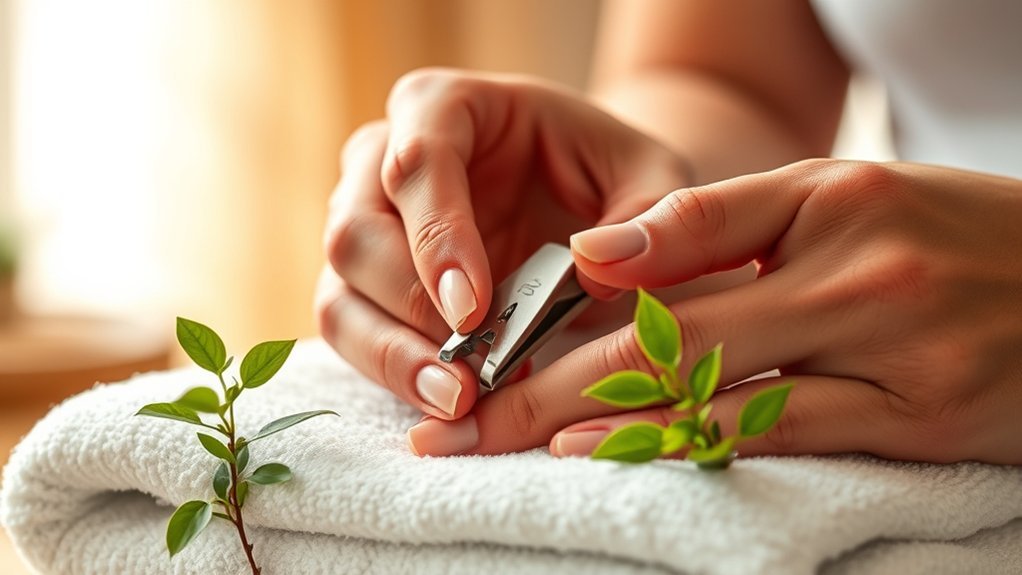Picture your hands, the tools of your daily life, adorned with neatly trimmed nails that reflect care and attention. Yet, many overlook nail trimming, leading to potential health issues that can arise from improper techniques and neglected hygiene. These problems often stem from a lack of knowledge and can affect anyone, especially those with underlying health conditions. Understanding the causes and risks can help you prevent complications and keep your nails healthy.
Importance of Proper Nail Care
While you mightn’t think much about your nails, proper nail care is essential for maintaining overall health. Healthy nails can indicate good hygiene and nutrition, while neglected nails may harbor bacteria or fungi, leading to infections.
Regular trimming helps prevent hangnails and reduces the risk of nail injuries. Keeping nails clean and moisturized also minimizes the chance of splits or breaks, which can be painful and inconvenient.
Additionally, well-groomed nails enhance your appearance and boost your confidence. Remember to use proper tools, like sharp nail clippers and a fine file, to avoid damaging the nail bed.
Ultimately, investing time in nail care not only promotes better physical health but also contributes to your overall well-being.
Common Nail Trimming Mistakes
Many people overlook the potential pitfalls of nail trimming, often leading to mistakes that can compromise nail health.
One common error is cutting nails too short, which can cause pain and increase the risk of infection. Additionally, trimming nails in a curved shape instead of straight can result in ingrown nails.
Using dull or improper tools also poses a significant risk; they can cause tearing or splitting. Another mistake is neglecting to sanitize tools before use, which can introduce harmful bacteria.
Finally, many forget to moisturize the nails and surrounding skin after trimming, leading to dryness and brittleness.
Health Risks Associated With Improper Nail Trimming
Improper nail trimming can lead to several health risks that extend beyond mere discomfort. Neglecting proper techniques can result in infections, ingrown nails, and even chronic pain. These issues can affect your overall well-being and daily activities.
| Health Risk | Symptoms | Potential Consequences |
|---|---|---|
| Infections | Redness, swelling | Severe pain, systemic infection |
| Ingrown nails | Pain, skin irritation | Surgery, prolonged discomfort |
| Nail bed injuries | Bleeding, tenderness | Long recovery time |
| Fungal infections | Discoloration, odor | Nail loss, ongoing treatment |
Best Practices for Nail Trimming
To guarantee healthy nails and prevent complications, it’s essential to adopt best practices for nail trimming.
Start by using sharp, clean nail clippers or scissors to guarantee a precise cut. Trim your nails straight across to avoid ingrown nails, and round the edges slightly for comfort. Aim to trim nails every few weeks, keeping them at a manageable length.
Before trimming, soften your nails by soaking them in warm water for a few minutes. Always dry your hands and nails thoroughly afterward.
Be cautious around the cuticles; avoid cutting them to prevent infection. Finally, consider filing your nails to smooth any rough edges, promoting both aesthetics and health.
Following these steps will help maintain your nails effectively.
Seeking Professional Help for Nail Care
Even with the best practices in place for nail trimming, some individuals may still face challenges that warrant professional assistance.
If you struggle with nail fungus, ingrown nails, or underlying health conditions like diabetes, it’s essential to consult a podiatrist or a licensed nail technician. These experts can provide tailored care, ensuring your nails are trimmed safely and effectively. They’ll also offer advice on maintaining nail health and preventing future issues.
Additionally, if you feel anxious about trimming your nails or lack the dexterity to do it safely, seeking professional help can alleviate those concerns.
Prioritizing your nail care not only enhances your appearance but also supports overall foot health. Don’t hesitate to reach out for the expertise you need.
Frequently Asked Questions
How Often Should I Trim My Nails for Optimal Health?
You should trim your nails every two to four weeks for ideal health. Regular maintenance prevents hangnails and infections, promotes hygiene, and keeps your nails looking neat. Adjust frequency based on your growth rate and lifestyle.
Can Nail Trimming Affect My Overall Hygiene?
Nail trimming’s like keeping your home tidy; it directly impacts your hygiene. Regularly trimming your nails prevents dirt buildup and reduces the risk of infections, ensuring your hands stay clean and healthy. Don’t overlook this essential practice!
What Tools Are Best for Trimming Nails Safely?
For safe nail trimming, use sharp, high-quality nail clippers or scissors designed specifically for nails. A glass or crystal nail file can smooth edges, while a nail buffer adds shine and reduces snags.
Are There Specific Nail Trimming Techniques for Children?
Yes, when trimming children’s nails, use gentle pressure, hold their fingers steady, and trim straight across to prevent ingrown nails. Distracting them with a toy or singing can make the experience less stressful and more enjoyable.
How Can I Tell if My Nails Are Healthy?
You can tell if your nails are healthy by checking for a smooth surface, consistent color, and absence of ridges or spots. If they feel strong and flexible, you’re likely on the right track.
Conclusion
In summary, proper nail trimming is essential for maintaining your overall health. Many overlook this simple task, unaware that it can lead to serious complications, especially for those with conditions like diabetes. The theory that nail care is merely cosmetic doesn’t hold up against the evidence of its health risks. By following best practices and seeking professional help when needed, you can protect yourself from infections and injuries, ensuring your nails—and health—remain in top shape.
